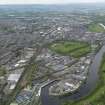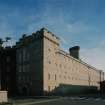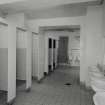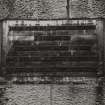Perth, Edinburgh Road, Perth Prison
Plague Burial(S) (Period Unknown)(Possible), Prison (19th Century), Ventilation Shaft(S) (19th Century), War Memorial(S) (Period Unassigned)
Site Name Perth, Edinburgh Road, Perth Prison
Classification Plague Burial(S) (Period Unknown)(Possible), Prison (19th Century), Ventilation Shaft(S) (19th Century), War Memorial(S) (Period Unassigned)
Alternative Name(s) Hm Prison Perth; Prisoner Of War Memorial Plaque
Canmore ID 148030
Site Number NO12SW 356
NGR NO 11786 22395
NGR Description Centred on Central Building
Datum OSGB36 - NGR
Permalink http://canmore.org.uk/site/148030
First 100 images shown. See the Collections panel (below) for a link to all digital images.
- Council Perth And Kinross
- Parish Perth
- Former Region Tayside
- Former District Perth And Kinross
- Former County Perthshire
NO12SW 356.00 11786 22395 (Centred on Central Building)
For discovery of flints, see NO12SW 26.
NO 117 223 A phased programme of archaeological works was undertaken at HMP Perth from January to March 2006 prior to redevelopment, together with ongoing monitoring of groundworks during construction. The redevelopment included the demolition of C Hall and the erection of a series of new buildings within and adjacent to the former C Hall. The site has been in constant use as a prison since the construction of a Napoleonic prisoner-of-war depot in 1811. It was converted to a general prison in 1842 and has subsequently undergone much remodelling throughout the 19th and 20th centuries.
Trial-trenching within the proposed development area exposed elements of both the Napoleonic prisoner-of-war buildings and the later Victorian structures. Within C Hall elements of a stone-built 'hub and spoke' airing or exercise yard and a tunnel structure relating to a probable Victorian air ventilation system were uncovered. Further excavation exposed elements of the 'hub and spoke' exercise yard. The airing yard was laid out in a 'wheel' plan with spokes running from a central hub. Each spoke of the wheel was a stone wall, with two walls forming a compartment narrowing towards the central hub. A prisoner was contained within the cell to 'exercise' while a prison warder was located in the elevated central tower, allowing clear surveillance of all compartments. This structure was designed to physically contain and visually restrict the prisoners while allowing them to exercise in the open air. Map evidence suggests that HMP Perth originally had three 'hub and spoke' airing yards, built between 1840 and 1851.
A historic building survey was undertaken within the basement of C Hall prior to demolition. Initial inspection of the basement identified seven blocked tunnel structures within the wall of a main tunnel which ran the full length of thehall. Excavations also exposed a tunnel structure running between C and D Halls. The below-ground and above-ground evidence suggest that the Victorian-period prison halls were ventilated by a series of tunnel structures linked to air shafts located within the exercise yards.
Monitoring of groundworks uncovered 20 burials, male and female, stacked in two rows. The burials were clearly part of a single event and lay a short distance outside the boundary of the formal prison burial ground. They are likely to be associated with an outbreak of plague or disease.
Archive and report to be deposited in NMRS. Report lodged with Perth and Kinross SMR.
Sponsor: Scottish Prison Service.
Candy Hatherley, 2006.
NO12SW 356.00 11786 22395 (Centred on Central Building)
The central building is also known as the central offices or inner entrance and originally had an octagonal tower or chimney (demolished c 1965).
NO12SW 356.01 11759 22405 Gate-house
NO12SW 356.02 11907 22281 Original Perimeter Wall
NO12SW 356.03 117 222 Watching brief; Human Remains
NO12SW 356.04 11700 22447 A Block
NO12SW 356.05 11815 22387 Main Block including A, B, C, D Halls
NO12SW 356.06 11702 22454 H Block
NO12SW 356.07 11724 22438 Governor's House
NO12SW 356.08 11759 22477 Hospital Block (L Block)
NO12SW 356.09 11808 22333 Exercise Yard
Architect: Thomas Brown 1840-44 (conversion of original prison to a General prison)
Robert Reid 1810-12
Robert Mathieson c. 1857 additions
EXTERNAL REFERENCE:
S.R.O
Plans: RHP 9269/2, 9270 Thomas Brown engraving, plan and elevation, plans, elevations and sections.
National Library
Reports of the General Board of Directors of Prisons in Scotland 1840-44
Lithographed plans and sections in Appendices to 1840 and 1842 volumes signed Thomas Brown, Charlotte Street, Edinburgh.
Plan of prison existing in 1840.
Desk Based Assessment (February 2005)
A desk-based assessment was undertaken by Headland Archaeology regarding HMP Perth in advance of refurbishment by the Scottish Prison Service. The main prison block – containing elements of the original Robert Reid building of 1810-12, as well as Thomas Brown’s work of 1840-42 and Robert Matheson’s work of 1852-57 – is a Category A Listed Building. There are also a number of Category B and C(S) Listed Buildings on the site. Map references suggest the site was agricultural in character until the construction of the Napoleonic prison in 1810. After two years of use as originally conceived, the buildings housed military equipment until 1833, and were then used as a granary until 1840 when the government began its conversion to the first general prison in Scotland. In the later 19th and 20th centuries there were considerable alterations to the historic layout of the site and its buildings.
Information from George F Geddes (Headland Archaeology) February 2005
Project code: PPJ04
Project (February 2005 - February 2008)
An archaeological project was undertaken by Headland Archaeology on behalf of AMEC regarding planned demolition and redevelopment work at HMP Perth. The archaeological work included a desk-based assessment, evaluation (trial trenching), excavation and historic building recording. A further archaeological evaluation was carried out in February 2008 during the third phase of the project.
Information from Candy Hatherley and George F. Geddes (Headland Archaeology) February 2005 - April 2006
Project code: PPJ04
Excavation (6 February 2006 - 16 February 2006)
Headland Archaeology was commissioned by AMEC, on behalf of the Scottish Prison Service to undertake an archaeological excavation and historic building recording at HMP Perth. This work forms part of a phased programme of archaeological works prior to redevelopment and follows an
archaeological evaluation within the prison grounds.
The archaeological excavation within C Hall exercise yard exposed further elements of a mid 19th century radial exercise yard and tunnel structure previously identified in the evaluation.
A detailed photographic and measured survey was undertaken within the basement of C Hall prior to demolition. This recorded a series of vaulted tunnel structures, believed to be associated with an air ventilation system.
Information from Candy Hatherley (Headland Archaeology) April 2006
Project code: PPJ04
Standing Building Recording (January 2006 - March 2006)
NO 117 223 A phased programme of archaeological works was undertaken at HMP Perth from January to March 2006 prior to redevelopment, together with ongoing monitoring of groundworks during construction. The redevelopment included the demolition of C Hall and the erection of a series of new buildings within and adjacent to the former C Hall. The site has been in constant use as a prison since the construction of a Napoleonic prisoner-of-war depot in 1811. It was converted to a general prison in 1842 and has subsequently undergone much remodelling throughout the 19th and 20th centuries.
Trial-trenching within the proposed development area exposed elements of both the Napoleonic prisoner-of-war buildings and the later Victorian structures. Within C Hall elements of a stone-built 'hub and spoke' airing or exercise yard and a tunnel structure relating to a probable Victorian air ventilation system were uncovered. Further excavation exposed elements of the 'hub and spoke' exercise yard. The airing yard was laid out in a 'wheel' plan with spokes running from a central hub. Each spoke of the wheel was a stone wall, with two walls forming a compartment narrowing towards the central hub. A prisoner was contained within the cell to 'exercise' while a prison warder was located in the elevated central tower, allowing clear surveillance of all compartments. This structure was designed to physically contain and visually restrict the prisoners while allowing them to exercise in the open air. Map evidence suggests that HMP Perth originally had three 'hub and spoke' airing yards, built between 1840 and 1851.
A historic building survey was undertaken within the basement of C Hall prior to demolition. Initial inspection of the basement identified seven blocked tunnel structures within the wall of a main tunnel which ran the full length of thehall. Excavations also exposed a tunnel structure running between C and D Halls. The below-ground and above-ground evidence suggest that the Victorian-period prison halls were ventilated by a series of tunnel structures linked to air shafts located within the exercise yards.
Monitoring of groundworks uncovered 20 burials, male and female, stacked in two rows. The burials were clearly part of a single event and lay a short distance outside the boundary of the formal prison burial ground. They are likely to be associated with an outbreak of plague or disease.
Archive and report to be deposited in NMRS. Report lodged with Perth and Kinross SMR.
Sponsor: Scottish Prison Service.
C Hatherley 2006
Trial Trench (11 January 2006 - 19 January 2006)
Headland Archaeology Ltd was commissioned by AMEC to undertake an intrusive archaeological evaluation at Perth Prison in advance of a demolition and redevelopment programme. The archaeological potential of the planned redevelopment derives from the site’s continued use as a prison since 1812. A desk-based assessment concluded that there was a high potential for elements of earlier prison structures to survive, although there was the possibility of later disturbance.
Trial trenching identified structural elements of the Napoleonic prisoner-of-war camp (1812) including the original enclosure wall. Elements of a mid 19th century radial exercise or ‘airing’ yard, along with two tunnel structures, potentially associated with the Victorian air ventilation system, were also identified.
Information from Candy Hatherley (Headland Archaeology) February 2006
Excavation (January 2006 - March 2006)
NO 117 223 A phased programme of archaeological works was undertaken at HMP Perth from January to March 2006 prior to redevelopment, together with ongoing monitoring of groundworks during construction. The redevelopment included the demolition of C Hall and the erection of a series of new buildings within and adjacent to the former C Hall. The site has been in constant use as a prison since the construction of a Napoleonic prisoner-of-war depot in 1811. It was converted to a general prison in 1842 and has subsequently undergone much remodelling throughout the 19th and 20th centuries.
Trial-trenching within the proposed development area exposed elements of both the Napoleonic prisoner-of-war buildings and the later Victorian structures. Within C Hall elements of a stone-built 'hub and spoke' airing or exercise yard and a tunnel structure relating to a probable Victorian air ventilation system were uncovered. Further excavation exposed elements of the 'hub and spoke' exercise yard. The airing yard was laid out in a 'wheel' plan with spokes running from a central hub. Each spoke of the wheel was a stone wall, with two walls forming a compartment narrowing towards the central hub. A prisoner was contained within the cell to 'exercise' while a prison warder was located in the elevated central tower, allowing clear surveillance of all compartments. This structure was designed to physically contain and visually restrict the prisoners while allowing them to exercise in the open air. Map evidence suggests that HMP Perth originally had three 'hub and spoke' airing yards, built between 1840 and 1851.
A historic building survey was undertaken within the basement of C Hall prior to demolition. Initial inspection of the basement identified seven blocked tunnel structures within the wall of a main tunnel which ran the full length of thehall. Excavations also exposed a tunnel structure running between C and D Halls. The below-ground and above-ground evidence suggest that the Victorian-period prison halls were ventilated by a series of tunnel structures linked to air shafts located within the exercise yards.
Monitoring of groundworks uncovered 20 burials, male and female, stacked in two rows. The burials were clearly part of a single event and lay a short distance outside the boundary of the formal prison burial ground. They are likely to be associated with an outbreak of plague or disease.
Archive and report to be deposited in NMRS. Report lodged with Perth and Kinross SMR.
Sponsor: Scottish Prison Service.
C Hatherley 2006
Measured Survey (1 March 2006)
Headland Archaeology was commissioned by AMEC, on behalf of the Scottish Prison Service to undertake an archaeological excavation and historic building recording at HMP Perth. This work forms part of a phased programme of archaeological works prior to redevelopment and follows an
archaeological evaluation within the prison grounds.
A detailed photographic and measured survey was undertaken within the basement of C Hall prior to demolition. This recorded a series of vaulted tunnel structures, believed to be associated with an air ventilation system.
Information from Candy Hatherley (Headland Archaeology) April 2006
Project code: PPJ04
Archaeological Evaluation (4 February 2008 - 6 February 2008)
Headland Archaeology was commissioned by Morgan Ashurst on behalf of the Scottish Prison Service to undertake an archaeological evaluation at HMP Perth. The work formed part of Phase III of an ongoing redevelopment programme to improve and modernise the facility, which has involved both demolitions and new builds across the site.
The archaeological evaluation was carried out between the 4th and 6th February 2008. The primary objective was to identify and record any surviving remains of the original perimeter wall and its associated internal ditch, or 'canal'.
A single trench measuring approximately 5m x 2.5m was excavated, using a wheeled mechanical excavator with a toothless ditching bucket. The heavily truncaed whinstone structure (018) identified at the north-eastern end of the trench was similair in nature and dimensions to that described in previous archaeological investigations, as the remains of the 1811 perimeter wall of the prison (Hatherley 2006).
All of the structures in the western portion of the trench were of 20th century date.
No further features, structures or deposits of archaeological significance were identified during the course of the evaluation.
Funder: Morgan Ashurst on behalf of the Scottish Prison Service
Headland Archaeology
Trial Trench (4 February 2008 - 6 February 2008)
Headland Archaeology was commissioned by Morgan Ashurst on behalf of the Scott ish Prison Service to undertake an archaeological evaluation at HMP Perth. The work formed part of Phase III of an ongoing redevelopment programme to improve and modernise the facility, which has involved both demolitions and new builds across the site.
The site was originally developed in the early 19th century as a Napoleonic prisoner-of-war camp; it was subsequently redeveloped into Scotland’s fi rst general prison in the 1840s. Plans of the site suggest that the general layout of the prison remained substantially unaltered over the 100 year period between the late 1850’s and late 1940’s, but was subject
to quite dramatic changes of the subsequent 50 years.
The evaluation was carried out adjacent to the B-Listed hospital block, scheduled for demolition as part of the Phase III works. The archaeological evaluation consisted of a single trench, excavated in the Estates Yard and revealed both the probable remains of the 1811 perimeter wall and a further, stone and concrete, structure of 20th century date.
Information from Kate Bain (Headland Archaeology) March 2008














































































































































































































